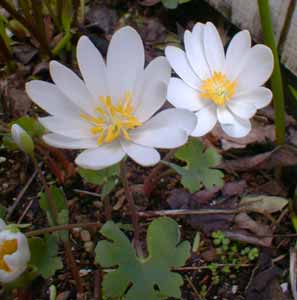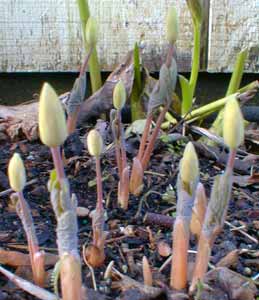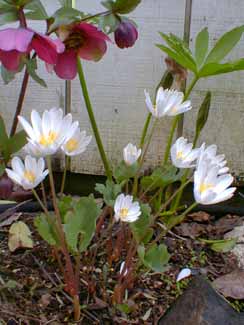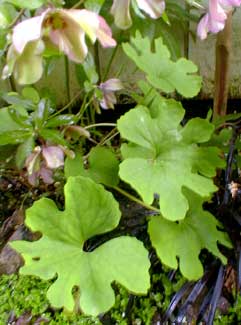 Sanguinaria canadensis:
Sanguinaria canadensis:
The Flower that Bleeds
"These lazy spring days
continue but how far away
those times called Long Ago!"
-Yosa Buson,
1716-1784
1716-1784
Bloodroot grows in North America from Nova Scotia to Florida, throughout the Apallachian mountains & Great Lakes region, to Nebraska & East Texas.
It found its way into English gardens at least by 1680 & gets praised in a handful of early gardening books & herbals as a plant of distinction, taste, & beauty.
Even so, it has never been commonly gardened, seemingly restricted to gardeners with refined tastes in shade plants & ephemerals.
It is one of those amazing plants with sufficient oddity plus wide range that it has scored colorful folk-names, including Indian Paint, Tetterwort, Paucoon, Red Pucoon, Coon Root, Red Root, Tumeric, Snakebite plant, or Sweet Slumber.
 Puccoon or Paucoon is its Algonquin name, referring to the redness of the root. As a powerful astringent & medicinal, Native Americans used it as an expecterant, to induce miscarriages, kill ringworm, treat snakebite, or as an occasionally effective cure for lung disease. Bloodroot shares some alkaloid properties in common with opium, being a relative of the poppy.
Puccoon or Paucoon is its Algonquin name, referring to the redness of the root. As a powerful astringent & medicinal, Native Americans used it as an expecterant, to induce miscarriages, kill ringworm, treat snakebite, or as an occasionally effective cure for lung disease. Bloodroot shares some alkaloid properties in common with opium, being a relative of the poppy.It was used as warpaint since the famously bleeding root works as a dye. But men of the Ponca tribe used it as a love charm. They would redden their hands with bloodroot dye & jump around in front of the woman they hoped to marry shaking reddened hands at her.
Bloodroot extract has been used in toothpastes & mouthwashes as a deterant to gingivitis gum loss. Though potentially toxic, it's not at all apt to kill you or a pet.
Its rhyzomes are as thick as a finger, & because these "fingers" bleed when cut, the plant just begs to be the subject of superstitions.
It reproduces very easily & is hardy, yet demand for the roots in folk remedies & for witchcraft rituals, as well as for gardens, has driven it to near exinction in many woodland areas.
 Today it is recommended never to collect more than the seeds from the wild. It will soon enough naturalize in the garden if properly placed & encouraged.
Today it is recommended never to collect more than the seeds from the wild. It will soon enough naturalize in the garden if properly placed & encouraged.It's one of the earliest & most beautiful spring flowers, as can be seen in the first & third photos on this page, both snapped in March (2004).
It initially pokes out of the ground as nubby pencils in February. In early March the short buds have elongated into stubby spears, as shown in the second photo. The leaves first appear as tubes wrapped around the bases of each upright flower buds.
Then at mid-March through early April the beds open into six-inch high daisy-like white blossoms of considerable charm. It is useless to pick these flowers, since the petals fall apart an hour after picking. They should be left in the garden until they develop their inch-long seedpods.
To fully appreciate the brief presence of the blooms in one's garden, the classic English garden commentator A. E. Bowles declared them one of the great joys of April, & in My Garden in Spring (1914) recommended sitting on a little garden stool in front of them so as to have "a long visit."
The foliage finishes developing after the flowers are in full sway. Leaves unfold from around the bases of golden flower-stems, growing larger & broader until they have become distinctive, rounded, five- to nine-lobed leaves.
 Even though the flowers are ephemeral, the leaves remain with a uniquely pretty presence right on through to summer. The final photo shows these leaves at mid-April, when the flowers are long gone. The leaves usually die back in autumn, but if there is a dry spell in summer they may die back then.
Even though the flowers are ephemeral, the leaves remain with a uniquely pretty presence right on through to summer. The final photo shows these leaves at mid-April, when the flowers are long gone. The leaves usually die back in autumn, but if there is a dry spell in summer they may die back then.So in all, a delicate presence in the garden, yet the root is dense & hardy, & it will return every spring pretty much forever.
We planted ours under hellebores which are much taller, & visible in the third photo. As the hellebores keep their leaves through the winter, there never seems to be a bare spot in that area of the garden, even after the bloodroot vanishes. The hellebores are in full flower late in winter & early spring, so when the bloodroot flowers appear, they make extremely pretty companions.
Like the hellebores, bloodroot likes some sun but needs a bit of protective shade in the course of the day. It also (like the hellebores) prefers a neutral pH rather than our garden's mostly acidic soils. We slightly amend the soil to suit the hellebores by pressing a stick of chalk into the root once a year, making the bloodroot & the hellebores particularly suited companions in that patch of earth.
If left to its own device & undisturbed, bloodroot will colonize its location, spreading both by roots & seeds.